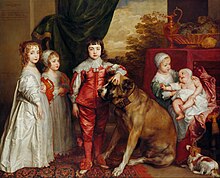The Graham Children
A gilded bird cage is suspended from a cord and Thomas sits in an ornate baby cart with a fine silver fruit bowl at his feet.The boys are captured in mid movement, like the cat and bird, while the girls seem to be completely still, so that the picture is both a snap shot of a fleeting moment and a static portrait simultaneously.[2] Thomas is fascinated by the glistening cherries held by his sister, which in Christian iconography represent the fruit of Paradise and the antidote to original sin, and for Henrietta symbolise the challenges she will soon face as she enters adulthood.[9][10] On the clock stands a small winged figure with scythe and hour glass representing the passage of time, while the smiling cat eyes the caged bird, referring to the fragility of life.[12][13][note 2] Hogarth included wit and pathos in the same scene by audaciously placing the predatory cat in one corner and the recently deceased child in the other.However, while Van Dyck (1599–1641) was commissioned by King Charles I to paint royalty, Hogarth's portraits were mainly of the rising middle class, and he never broke through to become a court painter.Portraits of individual children became more common than they had been in the seventeenth century and the idea of the "innocence" of childhood began to take root based on the view that the child was an uncorrupted blank slate as advocated by John Locke in his book Some Thoughts Concerning Education (1693).


William HogarthOil on canvasNational GalleryLondonDaniel GrahamapothecaryKing George IIRichard Robert GrahamLord DuveenSerpentine linesconversation piecebreechedRichardInfant mortalitybird-organRococoWilliam Gauntserpentine S'shistory paintingiconographyoriginal sinOrpheusscythehour glasscarnationsgoldfinchRedemptionRoyal CollectionAnthony van DyckKing Charles IJohn LockeSome Thoughts Concerning Educationportrait paintingNational Museum CardiffList of works by William HogarthOxford Dictionary of National BiographyOxford University PressPostle, Martin.Holburne Museum of ArtThames and HudsonYale University PressPast & PresentSue HubbardList of worksEmblematical Print on the South Sea SchemeThe Bad Taste of the TownA Just View of the British StageBefore and AfterThe Company of UndertakersStrolling Actresses Dressing in a BarnThe Distrest PoetThe Enraged MusicianCharacters and CaricaturasIndustry and IdlenessBeer Street and Gin LaneThe Four Stages of CrueltyColumbus Breaking the EggSatire on False PerspectiveCredulity, Superstition, and FanaticismFive Orders of PeriwigsJohn Wilkes Esq.The Assembly at Wanstead HouseA Harlot's ProgressA Rake's ProgressSouthwark FairScene from Shakespeare's The TempestFour Times of the DayThe Shrimp GirlPortrait of Captain Thomas CoramTaste in High LifeCaptain Lord George Graham in his CabinDavid Garrick as Richard IIIPainter and his PugThe Gate of CalaisHogarth's ServantsThe March of the Guards to FinchleyHumours of an ElectionSealing the TombHogarth Painting the Comic MuseThe BenchThe Lady's Last StakeSigismunda mourning over the Heart of GuiscardoMarriage A-la-ModeThe Analysis of BeautyLine of beautyHogarth's HouseSarah MalcolmHogarth ClubMary Edwards (Patron)